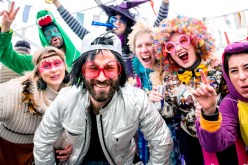Hidden Secrets of the World’s Most Famous Landmarks
Landmarks are akin to great presents. Like gift wrap, their facades are often striking, but once opened, they often reveal something you never expected. We’ve found ancient and modern landmarks from around the globe with secrets that are sure to surprise you.
There’s no doubt you’ll immediately recognize many of these popular attractions. Read on to discover the hidden rooms, symbols and meanings behind some of the world’s most famous landmarks.
The Washington Monument’s Symbolic Ties to the Vatican
In 1852, Pope Pius IX contributed a piece of marble from Rome’s ancient Temple of Concord to help build the Washington Monument after the Washington National Monument Society made a donation request. The marble was known as “The Pope’s Stone.”
The anti-Catholic Know-Nothing Party was so angered by the gift that several members nabbed the stone in 1854 and allegedly smashed it to pieces. A Spokane, Washington priest commissioned a new Pope’s Stone and installed it in 1982. A part of the original stone was recovered and placed on display in the Smithsonian Institution. But that’s not the only secret in D.C. …
The Capitol Building Depicts Washington as a God
Watching politicians and visitors from high above on the Capitol Rotunda’s ceiling is “The Apotheosis of Washington,” a fresco created in 1865 by Greek-Italian artist Constantino Brumidi. Recognizing George Washington’s unique place in American history, the painting shows the nation’s first president ascending to the heavens and becoming a god.
Painted after the Civil War and taking 11 months to complete, Brumidi’s Washington is depicted wearing a purple robe, a color associated with royalty, and is next to the mythological figures of Victoria and Liberty. The latter wears a Phrygian cap, a symbol of emancipation.
Westminster Abbey’s Cosmati Pavement Depicts the End of Times
Visit London’s Westminster Abbey and inside you’ll find an incredible pavement at the front of the High Altar. This amazing floor is believed to symbolize the end of times. Created in 1268, the pavement is named after the Cosmati family of Rome, who were famed artisans. It was hidden under carpeting for many years and only recently rediscovered.
The mysterious pavement measures 24 feet by 10 inches and includes purple porphyry, yellow limestone, and green serpentine as well as turquoise, cobalt and glass. Thirty-eight kings and queens have been crowned standing on the pavement. London’s secrets don’t end with Westminster, however …
Tower Bridge’s Symbol for Toll Collectors
Travel along the Tower Bridge and you’ll probably spot flags with an unusual mark that can also be found carved into stonework around London. The Bridge Mark is the emblem of the Bridge House Estates, a group formed by the City of London in 1282. The Bridge House Estates is tasked with the Tower Bridge’s maintenance.
The organization collects tolls and donations to keep the bridge in good shape and has built other bridges throughout London. The Bridge Mark has been used since the 17th century and is believed to symbolize the martyrdom of St. George.
Could There Be Alchemist’s Symbols at Notre Dame?
Could Notre Dame Cathedral, one of Christianity’s most famous landmarks, hide secret alchemical symbols? There are some who believe the church holds secrets revealing how to transform ordinary metals into gold.
Author Victor Hugo mentions the 850-year-old cathedral’s carving of a raven, a symbol tied to alchemy. Some also speculate that the central doorway’s medallions aren’t just Christian symbols, but alchemical marks.. There’s also a sculpture of angels mysteriously pointing to something, and a sculpture depicting an Apostle pointing towards the pointing angel. What could the sculptor have been trying to tell us?
The House of Commons’ Red Lines Prevent Bloodshed
Inside Britain’s House of Commons, visitors may spot double red lines on the carpet drawn by the front benches. The red lines measure two sword lengths that are one inch apart. They were created so that the Prime Minister would have enough time to draw his sword in defense should someone unexpectedly pull out a sword and lunge at him — or her.
While House members may no longer carry swords, “two swords length and an inch” is also a reminder to members of Parliament that it’s important to seek out peaceful resolutions when contentious issues arise.
The Great Wall of China’s Feminist Symbols of Peace
There’s a section of the Great Wall of China decorated with lotus blossoms, cloud carvings and fluffy balls, common symbols of peace in Chinese culture. But these ancient carvings were created by special artisans — the wives of the wall’s soldiers who were laborers. This area has come to be known as the “Feminist Great Wall.”
Archeologists discovered this ancient form of graffiti in 2004. It’s believed the ancient art was mandated by famed 16th century General Qi Jiguang during the Ming dynasty when the Wall was undergoing a period of renovation that included added watchtowers.
Mount Vernon’s Personal Appeal for Peace
George Washington’s Virginia estate has a cupola over the mansion with a symbolic weathervane that pleads for peace. In 1787, Washington tasked architect Joseph Rakestraw with creating something that would “have a bird … with an olive branch in its mouth … that it will traverse with the wind and therefore may receive the real shape of the bird.”
The weathervane Rakestraw created was made from copper with an iron frame and lead head. Although the original was a victim of pollution and had to be removed in 1993, a replica of the weathervane sits in the original’s place.
The Sphinx Was a Symbolic Security Guard
While the Great Sphinx of Giza has been thought to be an ancient Egyptian deity, it was also a subtle warning meant to convey that any potential looters needed to steer clear of the Necropolis.
The Sphinx hybridized the human and animal forms and is thought to symbolize a link between the mortal and immortal worlds. It has the head of a pharaoh placed atop of a lion’s body, symbolizing the Pharaoh’s descent from the gods. It was carved around 2500 B.C.E. during the reign of Egypt’s Old Kingdom Pharaoh Khafra.
St. Peter’s Basilica Secret Family Crest
Vatican City’s art is filled with many mysterious symbols, including those found in St. Peter’s Basilica. Inside is a spot known as St. Peter’s baldacchino, a pavilion-like area that’s 98 feet tall. Inaugurated in 1693, the columns supporting the baldacchino are decorated with bees.
However, the bees aren’t there to represent nature. They are symbolic of Pope Urban VIII’s family crest. The Barberini crest depicts three bees on a blue background along with a papal crown and St. Peter’s keys. The baldacchino is also decorated with lizards looking at the sun, a symbol of spiritual renewal.
The Taj Mahal: Symbol of Love or Intimidation?
For centuries, the world has marveled at the Taj Mahal, an ornate mausoleum created by Shah Jahan for his favorite wife, Mumtaz Mahal, who died in childbirth. Built from 1632 to 1647, it was thought to have been a symbol of Shah Jahan’s enduring love.
At the same time, the Taj Mahal was also a propaganda tool meant to intimidate. The grandeur and symmetry of the Taj Mahal and its gardens, along with its use of crystal, lapis lazuli, turquoise and other stones denoted the power and wealth of the Mughals. Today the shrine receives more than three million visitors annually.
The National Archives’ Guard Dogs Were Actually Pets
The National Archives was described by Herbert Hoover as a building designed to be “a temple of our history.” There are several symbols in the sculpture and artwork found throughout the building, including a group of dogs believed to symbolize the guarding of truth along with the documents contained inside the building.
Carved into the building’s north pediment, the dogs can be seen sitting off to the sides of a seated central figure known as the Recorder. The models for the dogs are believed have been the pets of sculptors James Earl Fraser and his wife, Laura.
Sydney’s Opera House’s Symbolic Tapestry
Completed in 1973, the Sydney Opera House stands out along the city’s skyline. This unique building was created by Danish architect JØrn Utzon, whose expressionist design has made the Sydney Opera House into an icon of Australia.
Utzon was known to experience synesthesia – the unusual ability to “see” sound. In honor of his contribution, Utzon’s daughter commissioned a tapestry, called “Homage to Carl Philipp Emmanuel Bach,” which is based on a painting created by her father of what he sees when he hears music. The tapestry proudly hangs in the opera house’s Utzon Room.
What Secrets Does a White House Desk Hold?
Sitting inside the Oval Office is the Resolute Desk, a gift given by Queen Victoria to President Rutherford B. Hayes in 1880. But the Resolute isn’t just any desk. It was created from the timbers of a British ship recovered by the United States.
In 1852, the HMS Resolute was sent to search for Arctic explorer John Franklin, but after being severely battered, the ship was abandoned by the crew on its return voyage. The U.S. discovered the ship and returned it to Britain as a gesture of goodwill. The desk’s carvings pay homage to several British arctic explorers.
Rio’s Christ the Redeemer Protected Against “Godlessness”
Overlooking Rio de Janiero is the incredible statue known as Christ the Redeemer. Completed in 1931, the idea for the statue came from a religious group known as the Catholic Circle that feared the separation of church and state would create a godless society. The statue was an appeal for the population to embrace religion.
The 98-foot-tall soapstone statue was created in an art deco style. It gazes over wealthy neighborhoods as well as the city’s favelas, or slums. The statue is covered in small tiles, and many of the statue’s laborers wrote personal prayers before cementing them to the statue.
The Hoover Dam Has a Symbolic Star Map
Bordering Nevada and Arizona, Hoover Dam was built between 1931 and 1936 as a massive irrigation and hydroelectric project. Inside, the dam has a terrazzo floor that contains a star map depicting the Northern Hemisphere at the exact moment of the dam’s dedication by President Franklin Roosevelt.
Designed by Oskar J.W. Hansen, the Hoover Dam’s star map was created to help future stargazers determine the exact time the dedication occurred. Hansen was a skilled sailor who used his celestial navigational skills to encode the exact time of the dedication.
The Supreme Court’s Cryptic Carving
In 1923, then-Chief Justice William Howard Taft tasked architect Cass Gilbert to create “a building of dignity and importance suitable for its use as the permanent home of the Supreme Court of the United States.”
Sadly, neither Taft nor Gilbert lived to see the building’s completion in 1935. However, Taft is remembered for serving as both a president and Supreme Court justice and is included in a carving above the court’s west entrance, depicting the former jurist in his youth. In fact, many presidential landmarks include secrets, including …
Mount Rushmore’s Secret Tablets
Mount Rushmore, one of America’s most famous monuments, just happens to contain a secret room. Located behind the head of Abraham Lincoln, the area was initially created as a Hall of Records by sculptor Gutzon Borglum, who hoped the secluded spot would hold and protect valuable historical documents.
While the room never wound up being used as intended, the Hall of Records now houses documents about Mount Rushmore as well as porcelain tablets detailing Borglum’s life. They were lowered into a hole that was sealed with a 1,200-pound capstone.
The Lincoln Memorial’s Hidden Symbols
Over the years, people have speculated about some of the Lincoln Memorial’s symbolism. According to the National Park Service, one theory that’s actually true is that the Lincoln Memorial contains several hidden symbols, including a bundle of wooden rods called fasces that denote leadership. The symbolic fasces serve as the majestic statue’s armrests.
Other symbols incorporated into the memorial include 36 columns denoting the number of states in the Union at the time of Lincoln’s death. The Lincoln Memorial was dedicated in 1922, with Robert Todd Lincoln, the president’s only living son, in attendance.
Statue of Liberty
A gift from France to America, the Statue of Liberty honors the United States’ commitment to freedom for all. While many visitors focus on Lady Liberty’s crown, torch and book, look down at her feet, and you’ll see a broken shackle and chain, showing her walking forward.
The broken chain at her feet symbolizes America’s abolition of slavery but later also came to honor those who have fled oppression. The cornerstone bears a plaque from the Freemasons. Conspiracy theorists believe the monument was actually a gift from the French Masons to their American counterparts.
The St. Louis Gateway Has a Hidden Time Capsule
St. Louis, Missouri’s Gateway Arch was designed to honor the westward expansion of the United States. While tourists flock to see one of the United States’ most popular landmarks, what’s hidden inside is also fascinating.
A time capsule containing 762,000 signatures from St. Louisans, was welded into the structure’s keystone in1965. On the day it was set in place, St. Louis students were invited to watch. “Children, when they grow up and have their own families, will be able to point to the arch and say their names are in it,” the event’s committee chairperson said.
The Hollywood Sign Didn’t Originally Symbolize Movies
The Hollywood Sign is now a symbol of California’s movie industry, but originally, it was used to promote a real estate development called “Hollywoodland.” The Hollywood Sign was erected in 1923 and was only supposed to stay up for a year and a half, but with the growing popularity of American films, a decision was made to keep it up.
Once the Great Depression hit, the sign fell into disrepair. In 1949, the Hollywood Chamber of Commerce offered to restore the sign but removed its last four letters in the process.
Secret Spirits Beneath the Brooklyn Bridge
The majestic Brooklyn Bridge is a popular landmark frequented by New York City tourists, but hidden deep beneath the bridge are passageways and vaults dating back to the late nineteenth century.
While the bridge’s hidden rooms would not have been comfortable living quarters, the underground area stays at a consistent temperature of 60 degrees — perfect for storing wine. Several wine and spirits distributors rented the rooms from the city. The Brooklyn Bridge’s underground area also served as a party venue when prohibition was repealed in 1934. Today the area serves as a storage area.
The New York Library’s Hidden Apartments
Hidden inside the New York City Public Library’s main branch by Bryant Park are apartments. The huge library system demand constant upkeep, and during the 19th and first half of the 20th century, the buildings were heated with coal, requiring a large maintenance staff.
To help ensure the library was adequately maintained for, the building was constructed with caretaker apartments. While in use, the apartments were inhabited not only by the caretakers, but also their families. Today, 13 library apartments remain across the city. However, most are used as storage facilities rather than as living quarters.
The Alamo’s Grisly Graffiti
The Alamo was once a Spanish mission in what is now San Antonio, Texas. However, in 1836, it was the site of the famous Battle of the Alamo, in which Texans waged war for independence from Mexico. The men who fought this battle left strange graffiti behind.
The markings read, “1802,” “WVANCE,” “TEX” and either “54” or “SA” and were discovered in 2011. Some historians believe Texans left them as the Mexican Army overran the Alamo. The Alamo has other graffiti tied to the men who fought and died there, including Davy Crockett.
The National Cathedral’s Hidden Space Rock
Washington’s National Cathedral may be thousands of miles away from the moon, but hidden in one of its stained glass windows is a tiny piece of moon rock. The rock was donated by Neil Armstrong, Buzz Aldrin and Michael Collins, who collected it during the Apollo 11 mission.
The seven-gram sample is encased in a nitrogen-filled, airtight capsule and embedded in a stained glass window. A ceremony dedicating the stone to the Cathedral occurred on July 21, 1974, five years after the historic lunar landing. The window where the rock is embedded is now known as the cathedral’s “space window.”
Kilroy Is Hidden in the World War II Memorial
During World War II, “Kilroy was here” was a popular phrase left behind as graffiti by U.S. troops wanting to make their mark while stationed around the globe. The military meme included a cute graphic of a man’s eyes and nose peeking over a wall.
To honor this iconic symbol, the World War II memorial in Washington, DC has two hidden “Kilroy was here” symbols carved into the landmark. The phrase came about thanks to a rivet inspector named James Kilroy who would write his name all over Liberty cargo ships to prove he’d completed their inspection.
Stonehenge’s Secret Carvings Revealed
The meaning of Britain’s ancient Stonehenge has puzzled people for hundreds of years. In 2003, however, some of its ancient secrets may have been unlocked. Using laser scanners, scientists discovered carvings undetectable to the human eye. Stonehenge is believed to have been constructed in 2300 BC, but scientists theorize the carvings were made sometime around 1800 BC.
Parts of three of the complex’s 83 stones were scanned, revealing carvings of axes, cups and daggers. “They seem in some sense to be commemorating the dead,” notes Tony Trueman of Wessex Archaeology in New Scientist.
Versailles’ Secret Apartments
Versailles is a palace that symbolizes both beauty and excess. Hidden inside this incredible estate are secret rooms, many of which were used as private apartments for discreet affairs. One of the apartments was kept by Madame Du Barry, a royal mistress and patroness of the arts.
Louis XV was so smitten by her that he gifted her with exquisite jewels and clothing, which she kept in her private apartment. Her room included a hidden door and stairway that connected to the King’s quarters. Her excessive lifestyle resulted in Madame Du Barry’s eventual execution by guillotine.
The Tower of London’s Six Ravens
The Tower of London is a historic British landmark, but not many people know that this iconic monument houses six captive ravens. The ravens are permanent residents thanks to a superstition that if the ravens fly off, the tower and Crown will fall.
It is believed that six ravens have been kept at the Tower of London since the 1600s. The birds even have their own caretaker, known as the Ravenmaster. The ravens are so beloved that during the bird flu epidemic of 2006, these avians were housed inside specially-constructed aviaries to protect their health.





